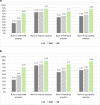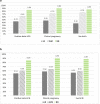Machine learning vs. classic statistics for the prediction of IVF outcomes
- PMID: 32783138
- PMCID: PMC7550518
- DOI: 10.1007/s10815-020-01908-1
Machine learning vs. classic statistics for the prediction of IVF outcomes
Abstract
Purpose: To assess whether machine learning methods provide advantage over classic statistical modeling for the prediction of IVF outcomes.
Methods: The study population consisted of 136 women undergoing a fresh IVF cycle from January 2014 to August 2016 at a tertiary, university-affiliated medical center. We tested the ability of two machine learning algorithms, support vector machine (SVM) and artificial neural network (NN), vs. classic statistics (logistic regression) to predict IVF outcomes (number of oocytes retrieved, mature oocytes, top-quality embryos, positive beta-hCG, clinical pregnancies, and live births) based on age and BMI, with or without clinical data.
Results: Machine learning algorithms (SVM and NN) based on age, BMI, and clinical features yielded better performances in predicting number of oocytes retrieved, mature oocytes, fertilized oocytes, top-quality embryos, positive beta-hCG, clinical pregnancies, and live births, compared with logistic regression models. While accuracies were 0.69 to 0.9 and 0.45 to 0.77 for NN and SVM, respectively, they were 0.34 to 0.74 using logistic regression models.
Conclusions: Our findings suggest that machine learning algorithms based on age, BMI, and clinical data have an advantage over logistic regression for the prediction of IVF outcomes and therefore can assist fertility specialists' counselling and their patients in adjusting the appropriate treatment strategy.
Keywords: IVF; Implantation; Machine learning; Oocytes; Prediction models.
Conflict of interest statement
The authors declare that they have no conflict of interest.
Figures



Similar articles
-
The number of oocytes retrieved during IVF: a balance between efficacy and safety.Hum Reprod. 2018 Jan 1;33(1):58-64. doi: 10.1093/humrep/dex334. Hum Reprod. 2018. PMID: 29136154
-
Conventional ovarian stimulation and single embryo transfer for IVF/ICSI. How many oocytes do we need to maximize cumulative live birth rates after utilization of all fresh and frozen embryos?Hum Reprod. 2016 Feb;31(2):370-6. doi: 10.1093/humrep/dev316. Epub 2016 Jan 2. Hum Reprod. 2016. PMID: 26724797
-
The number of oocytes associated with maximum cumulative live birth rates per aspiration depends on female age: a population study of 221 221 treatment cycles.Hum Reprod. 2019 Sep 29;34(9):1778-1787. doi: 10.1093/humrep/dez100. Hum Reprod. 2019. PMID: 31398253
-
Growth hormone cotreatment for poor responders undergoing in vitro fertilization cycles: a systematic review and meta-analysis.Fertil Steril. 2020 Jul;114(1):97-109. doi: 10.1016/j.fertnstert.2020.03.007. Epub 2020 Jun 16. Fertil Steril. 2020. PMID: 32553470
-
Evidence-based outcomes after oocyte cryopreservation for donor oocyte in vitro fertilization and planned oocyte cryopreservation: a guideline.Fertil Steril. 2021 Jul;116(1):36-47. doi: 10.1016/j.fertnstert.2021.02.024. Fertil Steril. 2021. PMID: 34148587 Review.
Cited by
-
DNA Methylation of Window of Implantation Genes in Cervical Secretions Predicts Ongoing Pregnancy in Infertility Treatment.Int J Mol Sci. 2023 Mar 15;24(6):5598. doi: 10.3390/ijms24065598. Int J Mol Sci. 2023. PMID: 36982674 Free PMC article.
-
Construction of the machine learning-based live birth prediction models for the first in vitro fertilization pregnant women.BMC Pregnancy Childbirth. 2023 Jun 27;23(1):476. doi: 10.1186/s12884-023-05775-3. BMC Pregnancy Childbirth. 2023. PMID: 37370040 Free PMC article.
-
Identifying key predictive features for live birth rate in advanced maternal age patients undergoing single vitrified-warmed blastocyst transfer.Reprod Biol Endocrinol. 2024 Oct 7;22(1):120. doi: 10.1186/s12958-024-01295-7. Reprod Biol Endocrinol. 2024. PMID: 39375693 Free PMC article.
-
The Application of Artificial Intelligence in Predicting Embryo Transfer Outcome of Recurrent Implantation Failure.Front Physiol. 2022 Jun 30;13:885661. doi: 10.3389/fphys.2022.885661. eCollection 2022. Front Physiol. 2022. PMID: 35846016 Free PMC article.
-
Application of machine learning algorithms and SHAP explanations to predict fertility preference among reproductive women in Somalia.Sci Rep. 2025 Jul 20;15(1):26301. doi: 10.1038/s41598-025-04704-y. Sci Rep. 2025. PMID: 40685342 Free PMC article.
References
MeSH terms
Grants and funding
LinkOut - more resources
Full Text Sources
Other Literature Sources

